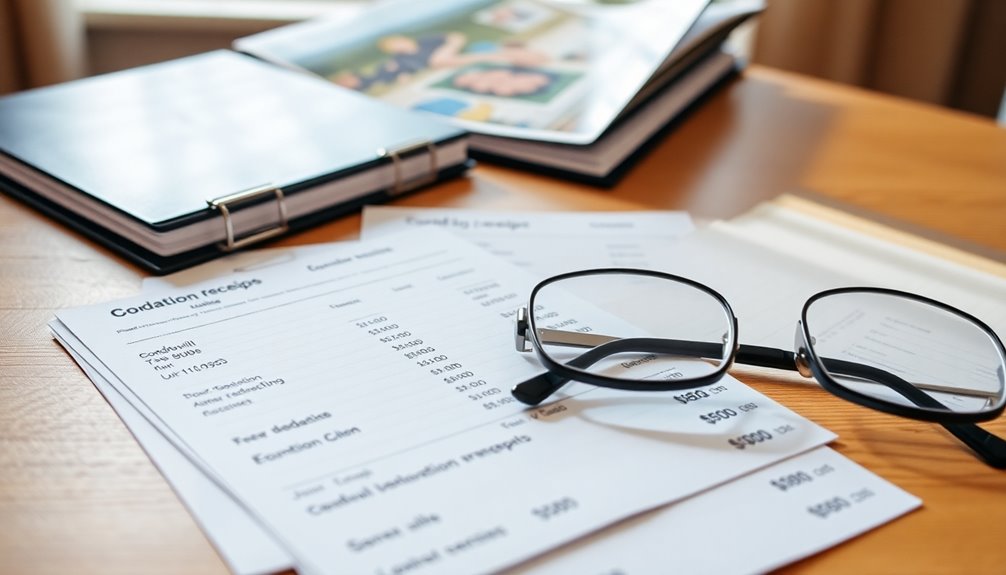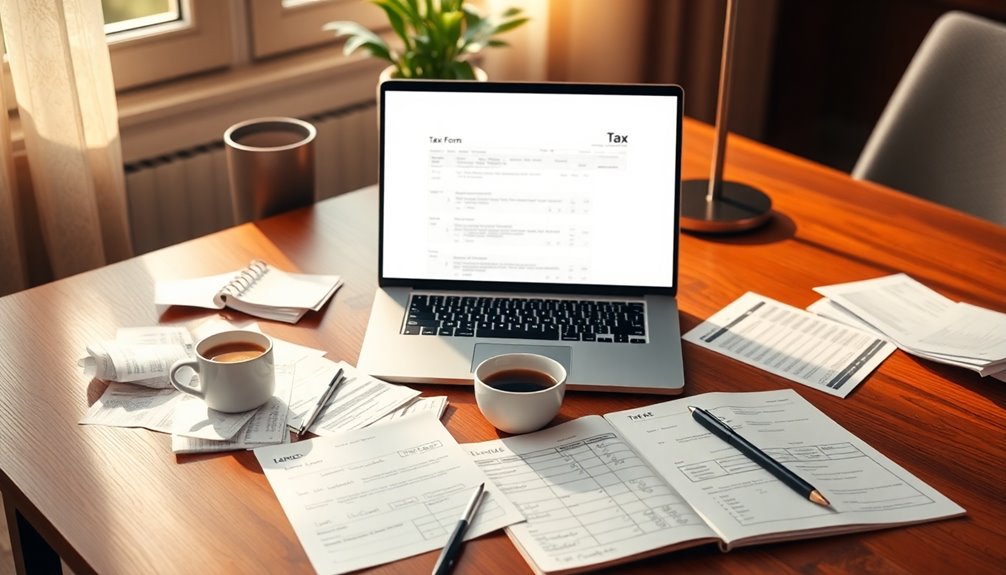You can leverage your Goodwill donations as tax deductions by giving to recognized charities like Goodwill. First, ensure your items are in good used condition and obtain a receipt for your contribution. You'll need to itemize deductions on Form 1040, Schedule A. Keep detailed records, including photographs and valuations, especially for noncash donations over $500, which require Form 8283.
Key Takeaways
- Ensure donations are made to recognized charitable organizations like Goodwill to qualify for tax deductions.
- Obtain a signed donation receipt from Goodwill and maintain a detailed list of items donated.
- Use Fair Market Value to assess donated items; refer to Goodwill's valuation guides for accuracy.
- Complete Form 1040 and attach Schedule A for itemized deductions; use Form 8283 for noncash contributions over $500.
- Keep all donation-related documentation organized, as the IRS may require verification during audits.
Eligibility for Tax Deductions

When it comes to claiming tax deductions for your charitable donations, understanding eligibility is crucial. To qualify, your donations must be made to recognized charitable organizations. This includes churches, mosques, synagogues, nonprofit schools, and 501(c)(3) charities.
Other eligible groups include volunteer fire departments, veterans' organizations, and public parks. Goodwill stores also fall under this category.
You can deduct both cash and noncash contributions. Cash donations cover everything from checks to online payments, while noncash donations can include clothing, household items, and even larger goods like vehicles. However, donations made directly to individuals or through platforms like GoFundMe aren't deductible.
To support your claims, keep thorough documentation. If your cash contribution is $250 or more, you'll need written evidence from the organization detailing the name, date, and amount of your donation. For donations exceeding $5,000, additional records or an appraisal might be necessary. Remember, you must itemize your deductions on your tax return (Form 1040, Schedule A) to benefit from these charitable deductions.
Ensure your total deductible expenses exceed the standard deduction to maximize your benefits. Accurate documentation is especially important for donations over $500, as it is a requirement for claiming deductions.
Valuation of Donated Items

Valuing your donated items accurately is essential for maximizing your tax deductions. To determine the fair market value, consider what a willing buyer would pay for each item in its current condition. You can use methods like estimated resale value or replacement cost. If any item exceeds $500, it's wise to obtain a qualified appraisal.
When estimating value, keep in mind the item's age, quality, and current condition. Goodwill provides valuation guides for various categories, including clothing, household items, and electronics. For instance, women's blouses might range from $4 to $9, while coffee tables can range from $15 to $100. Additionally, your contributions enhance local community resources and services, further emphasizing the importance of accurate valuation.
You can find price ranges in Goodwill's guides and IRS publications to ensure you're valuing items correctly. Online resources like fair market value calculators also help streamline the process.
Don't forget to accurately describe each item and record its value, as this will aid you in maximizing your deductions. By using these tools and resources, you'll have a better grasp on how to value your donated items effectively.
Documentation Requirements

Accurate documentation is key to ensuring your goodwill donations are fully recognized on your taxes. When you donate, make sure to obtain a donation receipt from Goodwill at the time of your contribution. For tax purposes, you'll also need to get a Tax Receipt from their website using your donation receipt ID number.
Don't forget that the paper tax receipt must be signed by the Goodwill employee who accepted your donation.
Keep a detailed list of the items you donated, noting the number of bags or boxes. If you donated items that don't fit into standard categories, describe them in the "Other" section. Additionally, maintain records like photographs, canceled checks, or receipts, which can support the value of your donations. It's important to note that the donor is responsible for determining the value of the donated items.
If your noncash gifts exceed $500, you must attach Form 8283 to your tax return. Gifts over $5,000 require a qualified appraisal and the appraiser's signature on the same form.
Lastly, ensure your donations are in good used condition or better to qualify for any deductions. Keeping organized records will help you during any potential IRS audits or requests for substantiation.
Filing the Tax Deduction

To successfully claim your goodwill donations on your taxes, you'll need to file the appropriate forms and choose to itemize your deductions.
Start with Form 1040, which is required for filing tax returns and selecting itemized deductions. You'll also need to attach Schedule A to list your charitable donations along with other deductible expenses like mortgage interest and medical costs.
If your noncash charitable contributions exceed $500, you must complete Form 8283 and attach it to your tax return. Be sure to specify the tax year for each donation on your receipts, and accurately determine the fair market value of the items you donated. Using a donation value guide from Goodwill can help you estimate this. Additionally, remember that donations to Goodwill can be tax-deductible, which can further enhance your potential savings.
Keep all receipts and documentation organized, as the IRS may require them for verification. It's essential to have these records on hand, especially for larger donations.
If you're unsure about any part of the process, don't hesitate to seek free tax help resources available through the IRS website. Following these steps will help you maximize your tax benefits and ensure a smooth filing experience.
Special Considerations for High-Value Donations

When you're donating high-value items to Goodwill, it's crucial to navigate specific valuation and documentation requirements to ensure you maximize your tax benefits.
First, you'll need to determine the fair market value of your items, as Goodwill can't provide this information. If your donation exceeds $500, you'll need to complete IRS Form 8283. For items valued over $5,000, a certified appraisal is mandatory, and this appraisal must be attached to Form 8283. Additionally, it's important to remember that non-profit organizations cannot assign dollar values to in-kind gifts, placing the responsibility on you as the donor.
Make sure to obtain a receipt from Goodwill that includes the donation date, your name, and a space for the item's value. If you're donating a group of similar items collectively worth more than $5,000, you'll also need a certified appraisal for the entire group.
Keep in mind that accurate documentation is essential; it must reflect the value as of the donation date.
Lastly, remember that non-cash donations are limited to 30% of your adjusted gross income (AGI) for tax deductions.
Tools for Valuation Guidance

As you prepare to donate items to Goodwill, having the right tools at your disposal can simplify the valuation process.
Start by consulting donation value guides from organizations like the Salvation Army and Goodwill. These guides offer approximate values for commonly donated items, categorizing them into sections such as clothing, appliances, and furniture. If you can't find your item listed, a good rule of thumb is to use 30% of its original price as a starting point.
Additionally, consider using IRS Publication 561, which details how to determine the fair market value of your donated property. This publication clarifies that fair market value is essentially what your item would sell for on the open market, providing a solid foundation for your valuation. Notably, the Bankrate Promise emphasizes the importance of transparency in reporting, which can also guide you in understanding the valuation of your donations.
You might also benefit from online valuation tools, like those offered by Goodwill NNE and the Salvation Army. These calculators can help you estimate values based on the condition of your items.
Lastly, tax software programs, such as H&R Block, can guide you through the process of calculating the value of your donations and assist you in properly reporting them for your tax deductions.
Organizing Donation Records

Effective organization of donation records is crucial for maintaining transparency and ensuring compliance during tax season. Start by clarifying your goals for organizing these records. Consider whether you're streamlining internal bookkeeping, enhancing donor management, or simplifying tax compliance.
The complexity of your system should align with the size of your organization and the types of donations you receive—be it cash, in-kind, or online.
Plan your organization system by identifying essential information to track, like donor names, contact details, donation amounts, and dates. Separate donor information and donation details into interlinkable sections to enhance accessibility. Use correct data types for each field to minimize entry errors, and ensure unique identifiers to avoid data duplication. Additionally, remember that accurate documentation is essential for substantiating contributions during tax audits and claiming tax deductions.
When implementing your system, consider using appropriate tools, including AI, to maintain efficiency. Regularly review and update your records to keep them relevant and effective. Store everything electronically for easy access, which will simplify your tax compliance.
To ensure transparency, include necessary elements in donation receipts and maintain organized bookkeeping. Being diligent about these practices will make your tax season smoother and keep your operations running smoothly throughout the year.
Working With Tax Professionals

Organizing your donation records sets the stage for a smoother collaboration with tax professionals. They can help you determine the fair market value of your donated items, which is essential for accurately claiming deductions. By consulting a local tax advisor, you can assess the condition of your items and use resources like Goodwill's Donation Value Guide to estimate their worth. Additionally, understanding the tax deductibility of goodwill donations can enhance your overall strategy.
When it comes to tax forms, professionals assist you in itemizing deductions on your 1040 form, specifically Schedule A. For non-cash contributions exceeding $500, they'll help you complete IRS Form 8283, ensuring you provide all necessary details.
If you donate high-value items over $5,000, a qualified appraiser must evaluate them, and your tax professional can facilitate this. Additionally, tax professionals ensure compliance with IRS rules, verifying that Goodwill is a qualified organization and that your donations meet deduction requirements.
They'll also help you maintain proper documentation for possible audits and make sure you receive the necessary receipts and acknowledgments. By working closely with tax professionals, you can maximize your benefits and navigate the complexities of tax deductions confidently.
Maximizing Your Tax Benefits

To maximize your tax benefits from goodwill donations, timing and strategy are key. Consider donating in high-income tax years to offset your tax liability. If you anticipate a lower income year, deferring donations can help you maximize deductions when you need them most. Just make sure to donate by December 31st to claim those deductions for the current year.
You might also group donations in certain tax years to exceed the standard deduction, allowing you to itemize and get the most out of your contributions.
If you're over 70½, consider using Qualified Charitable Distributions (QCDs) from your traditional IRA. You can donate up to $100,000 annually without itemizing, which reduces your taxable income effectively. Donations to Goodwill are also tax deductible, enhancing your overall tax strategy.
Donor-advised funds are another option; they provide immediate tax deductions and let you distribute funds to charities over time.
When donating, ensure you accurately value your items using fair market estimates and keep detailed receipts. If your items exceed $500 in value, complete IRS Form 8283, and remember that items over $5,000 require a certified appraisal.
This careful planning maximizes your tax benefits while supporting your favorite causes.
Frequently Asked Questions
Can I Donate Items Purchased on Sale for Tax Deductions?
Yes, you can donate items purchased on sale for tax deductions.
The key is ensuring that the items are in good condition or better. When you donate, the fair market value at the time of donation is what counts, not the sale price.
Just keep a receipt from the charity detailing the items and their value. Remember, it's your responsibility to determine the value, so use guides to help you estimate accurately.
Are Donations Made by Businesses Eligible for Tax Deductions?
Yes, donations made by businesses can be eligible for tax deductions.
If you're operating a C corporation, you can deduct these contributions directly on your tax return.
However, if you're part of an S corporation, LLC, or partnership, you'll need to report them on your personal tax return.
Just make sure your donations go to qualified 501(c)(3) organizations, and keep detailed records to support your claims come tax time.
What Types of Items Are Not Deductible When Donated?
When you donate items that aren't in good used condition, like worn or out-of-style clothing, you can't deduct them.
If you don't have proper documentation, such as a receipt or written acknowledgment from the charity, your donation won't be deductible either.
Additionally, items valued over $500 may need a qualified appraisal, especially if they're not in good shape.
Always keep track of your donations to ensure compliance with IRS rules.
How Do I Handle Donations Made to Goodwill in Another State?
When you make donations to Goodwill in another state, you're still eligible for tax deductions, as Goodwill is a nationwide IRS-approved nonprofit.
Just be sure to get a receipt that includes the date and a brief summary of the items. You must also determine the fair market value of your donations.
Keep detailed records, and remember that the donation's tax year should match when you file your tax return.
Can I Claim Deductions for Items I Received for Free?
You can't claim deductions for items you received for free.
The IRS doesn't allow deductions for items that didn't cost you anything out-of-pocket. Even if you use these items for business, they're not deductible. The value is considered income instead.
If you're unsure about your situation, it's best to consult a tax professional to clarify any potential implications and ensure you're following IRS regulations correctly.
Keep your records organized for reference.
Conclusion
In summary, using goodwill donations on your taxes can be a smart way to maximize your deductions. By understanding eligibility, accurately valuing your items, and keeping thorough documentation, you can take full advantage of this opportunity. Don't forget to consult with a tax professional if you're dealing with high-value donations or need guidance. With the right preparation, you can make your charitable contributions work for you come tax season!









